| 1 | Emerald tree boa/green tree python |
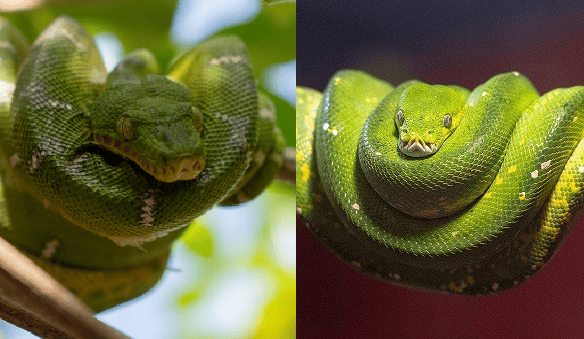
Around the world, there are various pairs of snakes which diverged 10s of millions of years ago, and are separated by thousands of miles, yet have evolved to become strangely similar, despite the distant connections between them. There’s no better example of this than the emerald tree boa and green tree python, found in Brazil and northern Australia (Queensland) respectively.
These snakes look so identical that only experts can tell them apart. In the international reptile trade, where both are popular due to their sedentary lifestyle, they’re constantly confused. Both species are juicy jungle green, overlaid with thin white stripes. Both species have a primitive, almost crocodilian skull structure. Both emerald tree boas and green tree pythons are ambush predators which go days or weeks without moving on their rainforest branches.
Similarly, their diets consist largely of mammals. Identical habitats have pressured them into evolving near identical characteristics, to fill the same ecological niche. The most extreme similarity is their ontogenetic colour transformation. Both species begin life as different colours, as a bright banana yellow or dense orange, and only become fully green in adulthood.
| 2 | Black mamba/coastal taipan |
These venomous species are slightly easier to distinguish, but fill virtually the same ecological niche. Black mambas appear in open savannahs of southern Africa, and coastal taipans in grassland and open woodlands of east coast Australia. Both belong to the Elapid family, but diverged at least 30 million years ago.
Despite this, similar environments have forced similar genes and DNA strands to activate in both. Both black mambas and coastal taipans move by day, and are fast, whippy species with immense agility. Both derive over 80% of their prey from mammals, including rats. Both climb trees occasionally, but prefer to stick to the ground. The similarities are uncanny, and this extends to their venom. Both black mambas and coastal taipans specialise in neurotoxins, dendrotoxin in the former and taipoxin in the latter. Both are exceptionally powerful, and have a specific purpose: to paralyse clawing mammals to prevent them from slashing back.
If a black mamba and coastal taipan came face to face, they’d probably greet each other like old friends. The two species even have similar mouths that create an illusion of a permanent smile.
| 3 | Asian vine snake/green vine snake |
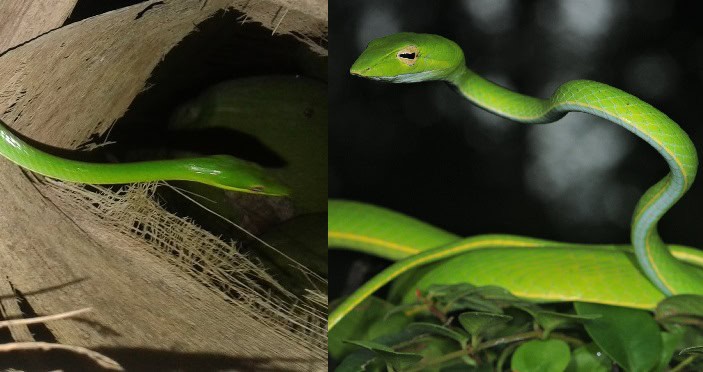
One of the most fruitful snake strategies is not just to live in trees, but become the tree. A handful worldwide take this to an elite new level, and none succeed quite like the Asian vine snake (Thailand) and green vine snake (Brazil). Both are mildly venomous and no threat to humans, and both spend the vast majority of their life on branches. But you could say that about many snakes worldwide. The crazy thing about these snakes is the extreme level of physical convergence, despite being only distantly related.
The first similarity is their extreme greenness, to blend with foliage, with zero additional patterns. Both Asian vine snakes and green vine snakes primarily prey on reptiles, including Indian garden lizards and giant ameivas respectively. The freakiest similarity is that both species are not just incredibly thin, but dangle with a prehensile tail and sway in the wind, to mimic a forest vine. The two species also share a highly elongated snout, and active foraging tactics rather than pure ambush.
The main difference is their pupils. Green vine snakes have round pupils, while in Asian vine snakes, they’re a bizarre keyhole shape.
| 4 | Eastern/South American hognose snake |
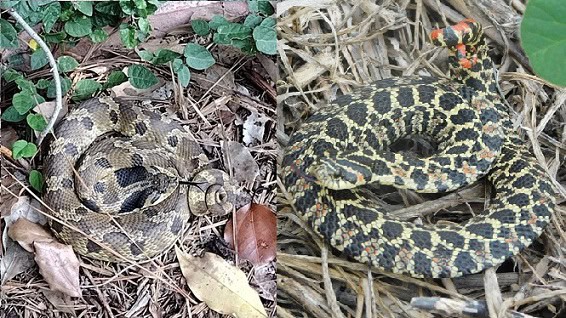
The eastern hognose snake was one of the earliest US colonists encountered, gaining the nickname “spreadin’ adder” due to their spreadable neck hood. A few colonists beat them to death due to closely resembling rattlesnakes. Little did they know that thousands of miles away in southern Brazil, there was a much closer clone: the South American hognose snake (Xenodon dorbignyi).
These species are only distantly related, yet have occupied the same habitat niche, and transformed physically to fit those habitats. Both eastern and South American hognose snakes have a reliance on sandy soils, whether in open grassland or spacious woodlands. Both species shun the thickest forests and marshy areas. Their common physical adaptions include a modified snout that allows for effortless digging, compared to a rattlesnake, whose face would get covered in sand.
Both hognose snakes are thick-bodied and relatively slow-moving, preferring to grind along deliberately and carefully. They even share advanced skills like spreading vertebrae sideways and creating a neck hood. Unlike cobras, both species stay flat to the ground. Like any animal, eastern hognose snakes and Xenodon dorbignyi are distantly related, but these mirroring characteristics evolved independently of each other.
| 5 | Death adder/puff adder |
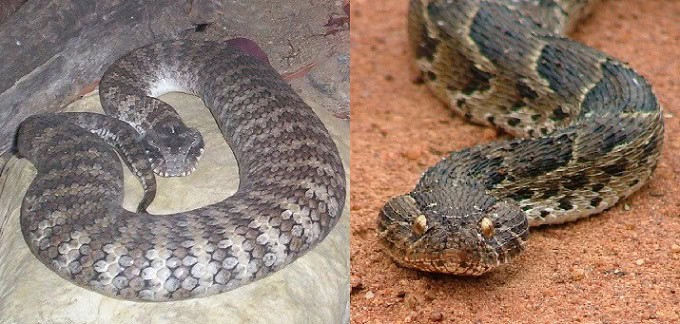
Black mambas and coastal taipans are a fast and energetic parallel, but there’s also a lazy tank parallel between Australia and Africa: the death adder and puff adder respectively. Both are dangerously venomous, and capable of ending human lives if untreated with antivenom (which is plentifully stocked).
The similarities begin with their hunting strategies. Both puff adders and death adders are ambush predators which position themselves in overgrown thickets, and wait for days for prey to arrive. They both tend to choose thickets adjacent to game trails or dog-walking paths, on the borders of forests rather than inside them.
Next there’s the body. Both puff adders and death adders are enormously thick relative to their length. This allows for a crushing pounce which can knock the wind out of their prey without even requiring venom injection. Both species have relatively dull shades to blend in, and a mammal-heavy diet which is nevertheless flexible. Again, the two species have moulded into similar predator niches, despite living thousands of miles away.
In fact, these parallels are more extreme, because they belong to different serpent classes. Puff adders are vipers (like almost all snakes called adders), but death adders are actually an elapid like the black mamba. Australia has no vipers species at all, just 80+ venomous elapids. Of all elapids on Earth, the death adders are closest to the slower, ambush-focussed lifestyle of an adder.
| 6 | Common garter snake/grass snake |
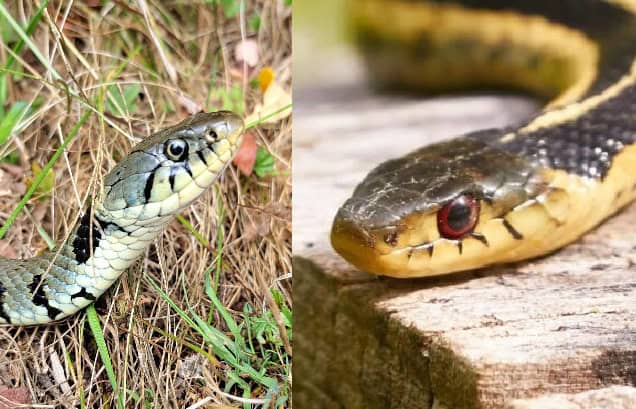
Snakes are masters at occupying any habitat. If there’s any vacancy in the ecosystem, then a new snake will set up shop there, and adjust its physical characteristics. If it takes millions of years, then so be it. Snakes have adapted to sandy dunes, underground root tunnels, scree slopes and underwater coral reefs. Scenic rivers are no problem, and in the mild English and Ohio countrysides, two species have evolved to become very similar: common garter snakes and grass snakes.
These belong to the Thamnophis and Natrix genera respectively, found far apart in North America and Europe. Both are semi-aquatic snakes which are most at home in small ponds floating on lilypads. Both prey chiefly on amphibians, including grey treefrogs and common frogs (UK). Both have a weak venom in their saliva which barely causes stinging if they bite your finger.
Grass snakes and common garters are harmless countryside creatures which tend to freeze if cornered. Marshes and ponds, even in backgardens, are a great place to find them, but during wet weather, they also appear in moist, grassy fields.
| 7 | Common catsnake/Malagasy cat-eyed snake |
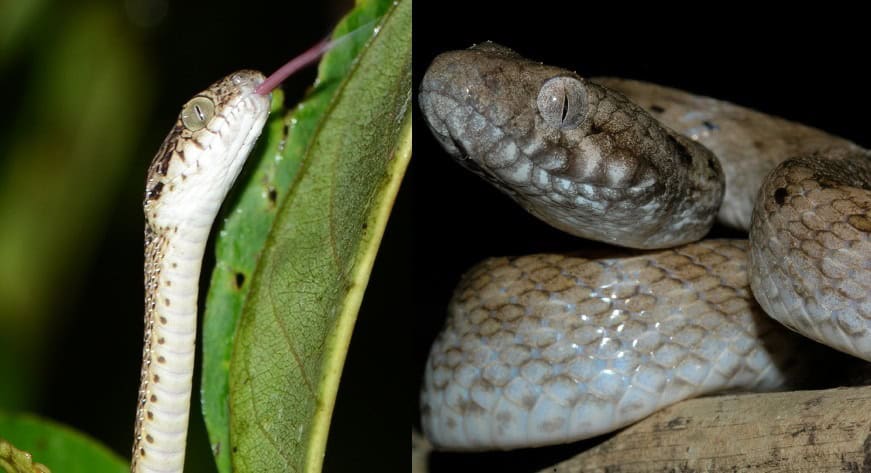
Madagascar is the experimentation lab of the snake kingdom, an isolated island and a pressure cooker where all sorts of weird creatures can mutate into being. Yet one of its most common snakes is a clone of the unrelated common catsnake (Boiga trigonata) thousands of miles away in India. This Madagascan snake is the Malagasy cat-eyed snake (Madagascarophis colubrinus).
At first glance, the two have a close resemblance in their beige-brown patterns, and the sharply vertical pupils which inspired their name. On closer inspection, the similarities continue. Both Boiga trigonata and M. colubrinus are expert tree climbers which spend plenty of time clinging to branches. They’re both highly flexible snakes, which appear in virtually any habitat where trees grow, from forests to a primary school yard.
Both snakes are also comfortable hunting on the ground. Their venoms are mild, yet the compositions are strangely similar. Malagasy cat-eyed snakes produce a neurotoxin called maculotoxin, which acts similarly to black mamba neurotoxins, yet is weak in humans. Boiga catsnakes also have seemingly powerful neurotoxins which are weak in practice. Both species are likely to be seen crossing branches nimbly at 10pm, on branches above your head, in India and Madagascar.
| 8 | Arabian horned viper/sidewinder |
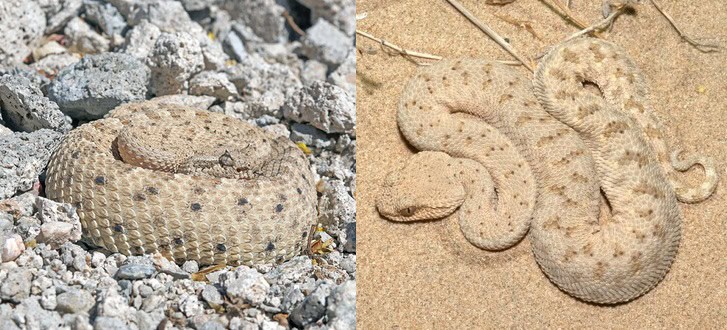
The ultimate desert vipers, these sand dune residents belong to very distant branches of the viper tree, yet have evolved to become extremely similar. Firstly, there’s their horns. Both Saharan horned vipers (Cerastes gasperatti) and sidewinders (Crotalus cerastes) have enlarged scales above their eyes, theorised to be for sun glare protection, in their Saudi Arabian and Arizona homes respectively.
Both have sandy-coloured scales, which are optimised for blending with the desert. Both have gnarly, jagged scales – this might be because the genes controlling the enlarged horns partially affect the whole body. Finally, both have evolved the desert survival trick of sidewinding. This sideways locomotion minimises contact with the searing desert sands, by reducing the bodily surface area used for propulsion.
Fate placed Cerastes gasperatti and sidewinders in similar habitats, and necessity made them clones of each other. Although both mirroring snakes are vipers, their divergence time was tens of millions of years ago. Their ancestors would have crossed continents via the Alaskan land bridge, in colder times of lower sea levels. Between the two species lie endless civilisations of grey steppe vipers, green jungle vipers, and pale prairie rattlesnakes. The two evolved their sand-surfing characteristics completely independently of each other. They also belong to different viper classes – old world vipers (Viperinae) and the pitvipers (Crotalinae).
| 9 | Eyelash vipers/bush vipers |

Our next pair is the exact opposite for vipers. In Africa, there are rainforests, and in Central America, there are equally large rainforests. In each continent, a group of vipers entered those jungled domains at different times, and mutated in exactly the same way. These are the Atheris bush vipers of Africa, and the Bothriechis eyelash vipers of the Americas.
These groups are incredibly similar despite diverging long ago. Both are primarily rich green, with some variation in colour depending on forest type. Both have keeled, rough appearances and are found resting menacingly on branches 1-3 metres high, or on top of thick bushes. Within rainforests, both have occupied the ambush slot rather than fast pursuer.
Species include the African bush viper (Atheris squamigera) and black-speckled palm pitviper (Bothriechis nigroviridis) of Costa Rica. Both groups prey most heavily on mammals, and can hunt on the ground, but prefer the comfort of a swaying branch. In Asia, meanwhile, the Trimeresurus green pitvipers have muscled into this ecological position, although they look slightly distinct, with parallel white lines and red markings.
| 10 | Black racer/oriental ratsnake |
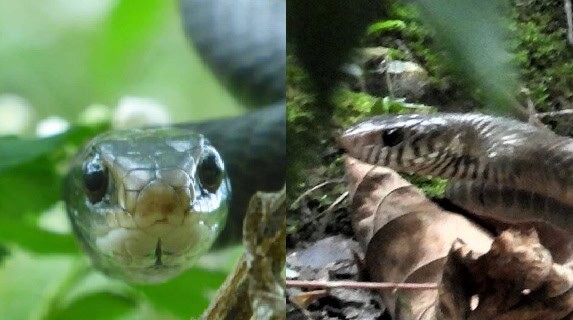
In the USA, the black racer is probably the cockiest snake, a fast-moving explorer which slithers through concrete pipes under bridges and weaves underneath swimming pool deck chairs. Their equivalent in India and Thailand is the oriental ratsnake, another confidence king among snakes.
Just as there’s always room for a green-coloured forest ambusher in the snake world, there’s always room for a jack of all trades. Both oriental ratsnakes and black racers are completely non-venomous, but strong at virtually all other snakes skills: biting, climbing, swimming, fleeing, grappling. Their hunting styles mirror each other, as neither are true constrictors, preferring to wrestle their prey and force them down through sheer determination, maybe while applying a loose coil.
Black racers and oriental ratsnakes are two of the longest snakes in the US and Thailand respectively. Both have round pupils and move exclusively by day. Only a fool would cuddle these creatures, as they have no hesitancy about snapping on your nose.
There’s one trait they’d rather not share: both oriental ratsnakes and black racers are recognised as predators by birds, and subjected to waves of squawking assaults by coordinated bird troopers. Both have a tendency to climb trees and examine nests curiously, so you can’t really blame the birds.
